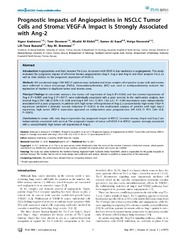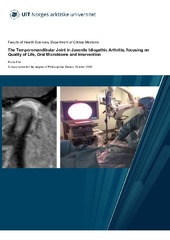Evaluation of hypoglycaemia with non-invasive sensors in people with type 1 diabetes and impaired awareness of hypoglycaemia
Permanent link
https://hdl.handle.net/10037/14059Date
2018-10-03Type
Journal articleTidsskriftartikkel
Peer reviewed
Author
Elvebakk, Ole; Tronstad, Christian; Birkeland, Kåre I.; Jenssen, Trond Geir; Bjørgaas, Marit Ragnhild Rokne; Frøslie, Kathrine Frey; Godang, Kristin; Kalvøy, Håvard; Martinsen, Ørjan Grøttem; Gulseth, Hanne LøvdalAbstract
People with type 1 diabetes and impaired awareness of hypoglycaemia (IAH) are prone to severe
hypoglycaemia. Previous attempts to develop non-invasive hypoglycaemia alarm systems have shown
promising results, but it is not known if such alarms can detect severe hypoglycaemia in people with
IAH. We aimed to explore whether a combination of non-invasive sensors could reliably evaluate
hypoglycaemia (plasma glucose (PG) minimum 2.5mmol/L) in people with IAH. Twenty participants
with type 1 diabetes and IAH underwent randomly ordered, single blinded hyperinsulinemic
euglycaemic and hyperinsulinemic hypoglycaemic clamps. Sweating, skin temperature, ECG,
counterregulatory hormones and symptoms of hypoglycaemia were assessed. Overall, we were not
able to detect clamp-induced hypoglycaemia with sufcient sensitivity and specifcity for further
clinical use. As a post-hoc analysis, we stratifed participants according to their ability to identify
hypoglycaemic symptoms during hypoglycaemic clamps. Five out of 20 participants could identify
such symptoms. These participants had a signifcantly higher adrenaline response to hypoglycaemia
(p<0.001) and were reliably identifed by sensors. Based on our observations, a non-invasive alarm
system based on measurement of sweating responses and ECG changes during hypoglycaemia might
provide an alert at a plasma glucose concentration around 2.5mmol/L if an adequate sympatho-adrenal
reaction is elicited.
Description
Source at: http://doi.org/10.1038/s41598-018-33189-1
Publisher
Nature ResearchCitation
Elvebakk, O., Tronstad, C., Birkeland, K. I., Jenssen, T. G., Bjørgaas, M. R. R., Frøslie, K. F., ... Gulseth, H. L. (2018). Evaluation of hypoglycaemia with non-invasive sensors in people with type 1 diabetes and impaired awareness of hypoglycaemia. Scientific Reports, 8, 14722, 1-11. http://doi.org/10.1038/s41598-018-33189-1Metadata
Show full item recordCollections
Related items
Showing items related by title, author, creator and subject.
-
Prognostic Impacts of Angiopoietins in NSCLC Tumor Cells and Stroma : VEGF-A Impact Is Strongly Associated with Ang-2
Andersen, Sigve; Dønnem, Tom; Al-Shibli, Khalid Ibrahim; Al-Saad, Samer; Stenvold, Helge; Busund, Lill-Tove; Bremnes, Roy M. (Journal article; Tidsskriftartikkel; Peer reviewed, 2011)Angiopoietins and their receptor Tie-2 are, in concert with VEGF-A, key mediators in angiogenesis. This study evaluates the prognostic impact of all known human angiopoietins (Ang-1, Ang-2 and Ang-4) and their receptor Tie-2, as well as their relation to the prognostic expression of VEGF-A. 335 unselected stage I-IIIA NSCLC-patients were included and tissue samples of respective tumor cells and ... -
The Temporomandibular Joint in Juvenile Idiopathic Arthritis, focusing on Quality of Life, Oral Microbiome and Intervention
Frid, Paula (Doctoral thesis; Doktorgradsavhandling, 2020-10-02)The temporomandibular joint (TMJ) is commonly involved in juvenile idiopathic arthritis (JIA), and may lead to impaired mouth opening, pain and facial growth disturbances. Asymptomatic TMJ arthritis may be diagnosed late in the disease course, thus management is challenging. The overall objectives of this thesis were to provide new knowledge on quality of life (QoL), the oral microbiome and interventions ... -
Humant papillomavirus : en litteraturstudie om HPV, dets relasjon til cancer og tiltak mot videre spredning av virus
Gabrielsen, Endre (Master thesis; Mastergradsoppgave, 2012-06-01)I 1983 oppdaget zur Hausen sammenhengen mellom Humant Papillomavirus (HPV) og livmorhalskreft. På denne tiden visste man ikke at det var HPV som var årsaken til at Helaceller kunne leve in vitro. Ny forskning relaterer HPV til en rekke andre cancertyper. En stor andel anal-, oropharyngeal-, penis-, vaginal-, og vulvacancer skyldes HPV. Det er også påvist HPV i tumorvev fra øsofagus, larynx, lunge, ...


 English
English norsk
norsk


